Efficiency
The difference in electrical generation efficiency between monocrystalline and polycrystalline panels is not that big, but it is still something to consider. Monocrystalline panels are slightly more efficient than polycrystalline panels, this is due to the wafer creation process. Since polycrystalline panels have wafers made from many crystals, they have less room for electrons to move, lowering the efficiency of electrical generation. Monocrystalline panels have an average efficiency of 15-20% whereas polycrystalline panels have an average efficiency of 13-16%. When purchasing solar panels, this should be taken into consideration as a higher efficiency will offset purchasing costs faster and reduce carbon emissions from energy consumption even more.

